I’ve been reading with great interest some of the posts and friendly debates that have taken place recently on this site concerning the relationship between art and science. As I read, I thought about the many artists I know who enthusiastically draw upon research conducted in the “non-art” fields of science and the humanities. Indeed, a lot of artists today are assuming the role of researcher, not with the idea of superceding scientific modes of inquiry, but in order to supplement or embellish upon them in ways that only art can.
One artist who is particularly adept at bringing multiple fields of inquiry together is Alison Ruttan, a Chicago-based interdisciplinary artist and Adjunct Associate Professor at the School of the Art Institute. Ruttan’s body of work revolves around the very basic — and yet infinitely complex — question of what makes us human. For the past several years, she has made a number of multi-disciplinary artworks that compare human and animal behavior. The types of questions Ruttan poses through her art are similar to those that are asked by an evolutionary biologist, for example, but Ruttan’s questions are open-ended and intended, as she puts it, as “a conversation between the maker and the viewer.” As an artist, Ruttan seeks “a better understanding of the way biology guides our own actions.” At the same time, she asks us to consider the degree to which human beings are themselves held captive by the idea of the “primal impulse,” whether that impulse is for food, sex, or violent conflict.
Ruttan’s most recent project is titled The Four Year War at Gombe. In it, she uses human actors to restage the civil war that took place within a troop of chimpanzees living in the Gombe Stream Chimpanzee Reserve in western Tanzania. This group of chimpanzees lived peacefully together for many years before violently separating into two distinct communities. Relying on Jane Goodall’s extensive research and documentation of this particular group of chimps, Ruttan asked her participants to loosely act out scenes that were depicted or otherwise described in Goodall’s book, Through a Window: My Thirty Years with the Chimpanzees of Gombe. Goodall’s observations led not only to the discovery that chimpanzees wage war on one another, but that they are also capable of long range-planning and strategic thinking. In turn, Ruttan’s investigations lead her to surmise that for chimpanzees, like us, “the bloodiest feuds and civil wars are always waged against those whom we have the closest ties to.”
I asked Alison Ruttan to tell us a bit more about her Four Year War project, and the role that research plays in her art-making practice.
Claudine Ise: The tribe of chimpanzees that inspired your project The Four Year War at Gombe was extensively documented by Jane Goodall. Can you tell us about Goodall’s work with this particular tribe? What happened to the chimpanzees over the course of Goodall’s research?
Alison Ruttan: Goodall began researching this particular chimpanzee troop in 1960. Her first ten years at Gombe in Tanzania were spent gaining the group’s trust and understanding the individual relationships within the group. During that time, Goodall wrote about familiar relationships — sex, affection and cooperation, social hierarchies and death in the community. Initially she had seen the chimps as almost pure, maybe nicer than human beings. By 1971, this perception began to change when the troop split into two communities and she and her staff witnessed chimps conducting outright warfare. The original group strategically hunted down and killed all the former members of their group. Goodall sadly recognized that like us, chimps also had a dark side.
CI: Some of your earlier series of videos and photographs dealt with human sexual behavior, among other subjects. What led you to Goodall’s research on chimps and other primates?
AR: I have always been interested in this question of “why do we behave the way we do”? At the time I was working with sexual imagery, I had been reading about gender differences and was beginning to become interested in the new research coming out of biology. This new theory began to question the idea that we are shaped primarily by our experiences and suggest that there is some behavior that is simply ”hardwired” into our behavior. The pornographic animations were a experiment, albeit a funny one that was essentially trying to strip the image down to the barest amount that could still trigger a sexual response.
After 9/11, it wasn’t really that hard to see how switching to questions on aggression came to the forefront for me. I started reading extensively in the area of evolutionary biology, with a focus on primates because they are our closest biological relatives (there is less then 2% difference in our DNA). We are both part of the newer primates, having branched off from a common ancestor some 4-5 million years ago. It seemed to me that if you could strip away all the shared behavior, you might begin to see what was “human.”
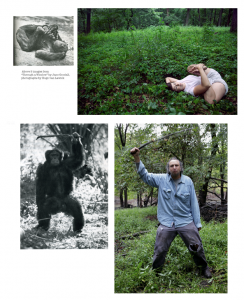
Black and white images by Hugo van Lewick; top left, from the book "In the Shadow of Man" by Jane Goodall; bottom, from "The Chimpanzees of Gombe," by Jane Goodall. Both color images by Alison Ruttan.
CI: What interested you about the Gombe troop’s particular story?
AR: What amazes me about so much of the writing on primates is how personal it is. Individuals are named and their histories are carefully described. Reading about the war at Gombe felt like witnessing our own origins story: rudimentary, but still a precursor to our own civil wars. I’ve read that on average, there are one hundred and twenty-five wars going on at any given time in the world. Five hundred people a day on average die in civil conflicts. I think I started this project because it’s just so depressing that as the “smarter ape,” we still haven’t come up with a better solution to conflict. What we think will be expedient just escalates until we don’t even remember what we were fighting about. This story for me questions the idea of trusting your instincts. Sometimes I think our biology cannot keep up with culture changes and we are just getting better at destroying things…. Curiously, warfare as seen among the chimpanzees has yet to be documented among the bonobo, who have a female-dominated culture. Do females have less of a taste for war?
CI: How did you find the “actors” to enact the scenes from Goodall’s book? Were you looking for any particular qualities?
AR: I started by talking my family into helping me out on a family vacation. I knew my nephews would cooperate if I offered to let them pour buckets of fake blood on each other. I found I liked working with people I knew, so on later shoots, I dragged friends, neighbors, and students of mine into the project. At one point, when I needed numerous small children for a scene, I went knocking on the doors of anyone who had left a stroller out in their yard. I was able to gather a half a dozen kids that way.
I spend time at the beginning of a shoot telling the actors about their character, and what is happening in the scene we are shooting. I show them clips of chimpanzee behavior and explain things like “chimpanzees often seek reassurance before a fight by reaching out and touching a best friend.” Or “peering (close staring) is a form of polite begging,” or “if a male is interested he might sit with his legs open to the female.” I talked about how I wasn’t looking for parody but wanted to fold in behavior that was particular but not quite human.
CI: How did you decide on the costuming, setting, and interactions?
AR: The incidents at Gombe happened between 1971-1974. I chose to costume the actors in clothes that would have suited a “back to nature” communal group from that same period. I am interested in suggesting a parallel story of the unraveling of a community that functions as a second interpretation of the same events. That period was also one in which established institutions and social norms were rejected in favor of alternative lifestyles and communities. Most of the scenes in the series were shot along the Desplaines River in Illinois. The flats are an area of decomposing matter and often lush plant life that grows overnight or dries into dust in the harsh sun. I liked the primordial quality of this urban forest; it seemed to set the right tone for this dark tale. Each scene was fairly well planned. I actually wrote a script, storyboarded the scenes, and sourced photographs of individual gestures from Goodall’s own research. I also stayed open to what was interesting on scene, improvising on the spot.
CI: Describe the process of shooting the murder scenes.
AR: That was actually a lot of fun. I’m not too bad at making fake blood, scars, and scrapes. My painting background does still come in handy. I worked with quite a few teenagers who I think thought this was the highlight of their summer. I did end up restricting the blood scenes so that each murder wasn’t always explicit. I found that in a photograph the falseness of the construction shows much more than in film, where you really can’t look that closely.
CI: Did Goodall have any theories as to why some members of the chimpanzee troop turned on the others?
AR: Goodall is not clear on this, but a number of possibilities have been suggested by others. It might have been an uneven ratio between male and female populations, food scarcit, and territorial protection or perhaps a festering grudge; chimps are known to have long memories.
CI: Much of your work involves a heavy amount of research into a particular subject. Numerous artists nowadays think of research as fundamental to their practice — a development which I find really interesting. What I’m curious about is the conceptual process of “translating” that research into a definitive aesthetic form which, in the case of your Four Year War project, is photographic objects and videos. But you’ve also made drawings of primates in previous bodies of work. Can you talk about the different ways you have given form to your research? How do you decide on a final form?
AR: For me, the research I do allows me to examine questions I have about the world but it doesn’t necessarily get me any closer to sharing something meaningful with you/the viewer. In much of my work, I am thinking about this problem of communication — i.e., how do my tools such as medium, craft and style set the stage for the conversation I want to have with you? The Four Year War is basically an anti-war piece. A big part of what interests me in this project is finding a way to engage viewers in philosophical questions about who we are and what we want to be. I knew I needed to create a more complex tableaux for that to happen, so I began thinking about this history as a story, a story that was the same and yet different. Stories, more than any other expression, access our ability to empathize — something I knew was important to this project.
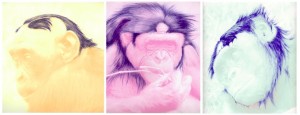
Alison Ruttan, "Individuation in Bonobo Grooming Habits," ballpoint pen on archival tinted inkjet paper.
In the series of drawings, titled Individuation in Bonobo Grooming Habits, that you refer to, a theoretical proposal is folded into an artwork. The project documents my discovery that bonobos are expressing themselves through distinct and individual “hair styles.” This is real; I have documented this at several zoos and have done background checks on when and how it started. My project suggests that social tools, especially those that can be seen as learned behavior versus instinctive actions, are in fact the beginnings of socialization and culture. The choice to present the idea as a combined photographic document and a drawing (interpretive) on top of it was to present two forms of understanding truth together. The color-tinted photographs feel Pop-like and the ballpoint pen, while studious, is still irreverent as a medium. By refusing to unify the point of view through a cohesive material presentation, the work undercuts my authority and places the responsibility of interpretation back on the viewer. To me, this is why art is different than science. It remains speculative, a conversation between the maker and the viewer.
You can learn more about Alison Ruttan’s work by visiting her website: www.alisonruttan.com.

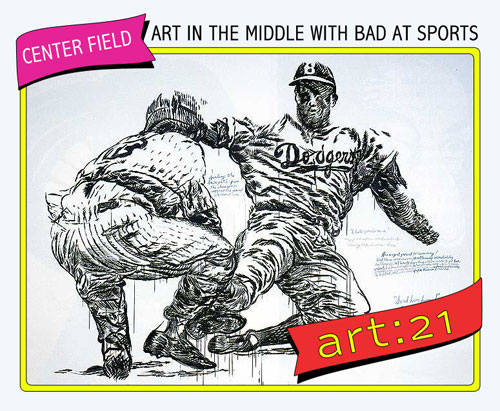
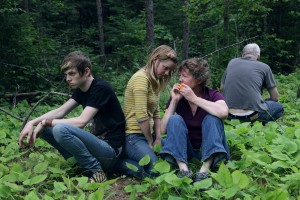
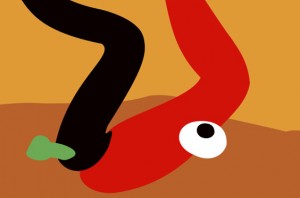
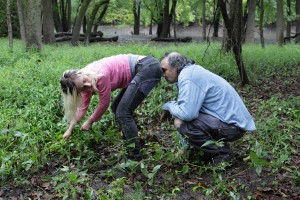




Pingback: Center Field | Alison Ruttan’s “The Four Year War at Gombe” : Bad at Sports